Be bold, homeless reform expert urges
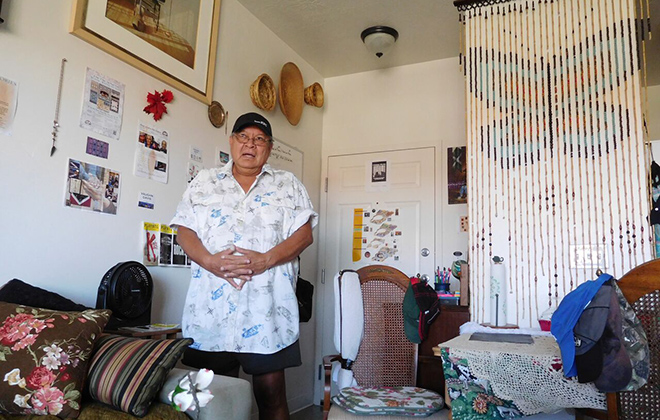
Vaughn Davis, 61, a full-blooded Navajo, refuses to drink or use drugs in his new “Housing First” apartment, even though he could. After four brutal winters living on the streets of Salt Lake City, Davis does not want to run the risk of becoming homeless again. “I’m not going to screw this up,” he said.
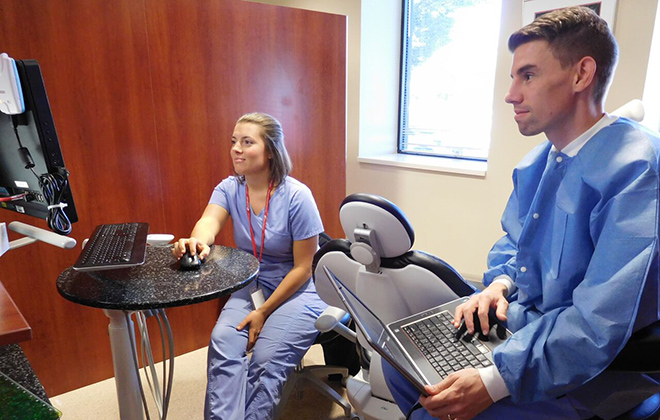
Cassandra Murphy and Trenton Adams, fourth-year dental students at Roseman University of Health Sciences, volunteer at Salt Lake City’s Fourth Street Clinic. Earlier in the day they extracted two teeth from a patient. “Drugs make their oral health considerably worse,” Adams said.
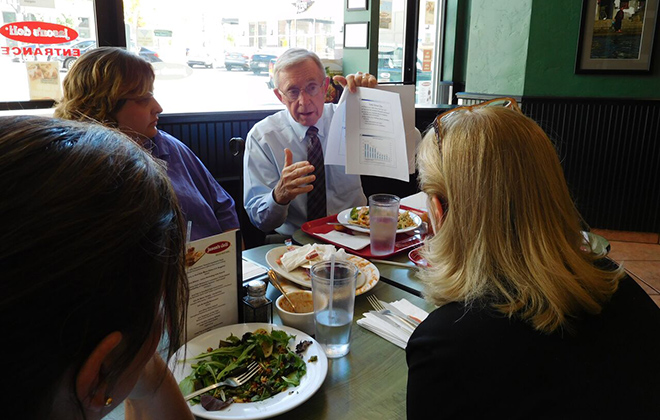
Over lunch, Lloyd Pendleton, Utah’s retired homeless coordinator, shows homeless housing data to a contingent from Rock Springs, Wyo., that drove three hours to learn how to get started to house the homeless there.

The St. Vincent de Paul Dining Hall on Salt Lake City’s notorious Rio Grande Street feeds 450 to 600 low-income and homeless people every night. It relies on volunteers and donations. The soup kitchen is part of a complex that includes The Road Home homeless shelter and a third building where a judge presides over “homeless court” so homeless people with criminal issues can avoid jail.
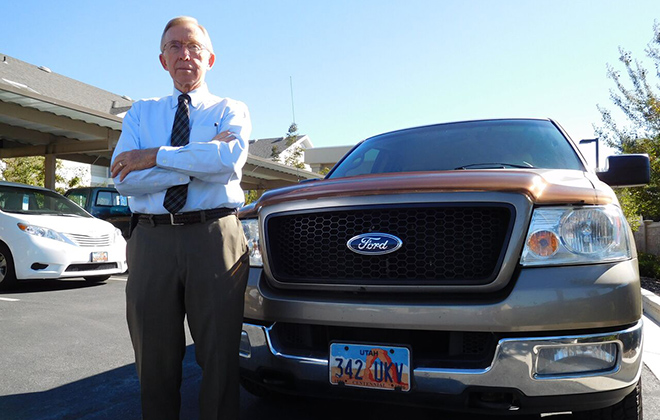
"If you think you can, or you think you can’t, you’re right either way. It can be done if you want to.”
Lloyd Pendleton
As Utah’s homeless coordinator, Pendleton, pictured above, helped Utah reduce its chronic homelessness by 72 percent since 2005. Salt Lake City also became the second city to eliminate the problem of chronically homeless veterans.
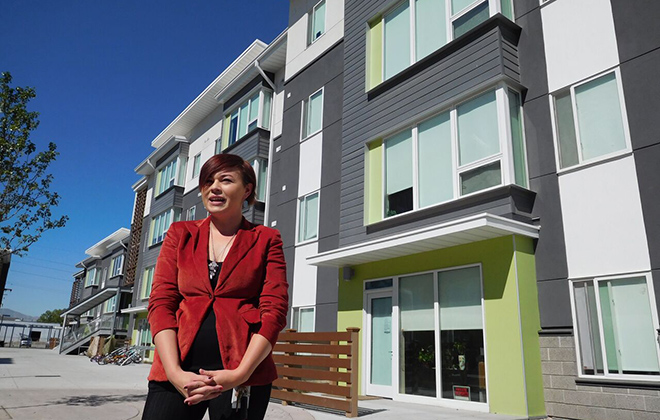
Jenn Anderson, assistant manager for Salt Lake City’s first “mixed-income housing” project called the “Bud Bailey Apartments,” stands in front of one of the project’s five buildings that house a combination of fair-market tenants, low-income workers and homeless people.






SALT LAKE CITY >> The white-haired, bespectacled, tie-wearing rock star of modern-day homeless reform insists that Hawaii officials should try something bold — and soon — to address island homelessness.
Lloyd Pendleton believes that people in Hawaii will be surprised by the results.
“Start doing it now,” Pendleton said as he pressed down on his lizard-skin cowboy boot to propel his Ford F-150 truck through a yellow traffic light. “You can analyze yourself to death. Just start doing and learning as you go.”
Salt Lake City — and Pendleton, in particular — is attracting attention from communities across the country that are searching for answers about what to do with their own homeless populations.

This year, Salt Lake City became America’s second city to end “chronic veterans’ homelessness,” just after Phoenix. And it’s reduced overall chronic homelessness by 72 percent since 2005. (The U.S. Department of Housing and Urban Development defines chronic homelessness as a person who has been homeless for longer than a year, or has been homeless four times in three years and has a disabling condition.)
Don't miss out on what's happening!
Stay in touch with breaking news, as it happens, conveniently in your email inbox. It's FREE!
Unlike more dense cities such as Honolulu, Seattle and San Francisco, Salt Lake City enjoys relatively affordable land and housing costs. But its success in housing the homeless goes far beyond cheap real estate.
The city, county and state have pulled together various religions, not just the Church of Jesus Christ of Latter-day Saints, and persuaded free-market landlords in one of the reddest of red states to rent apartments to homeless people who may be drinking, using drugs and dealing with mental health issues.
From City Hall to Utah’s state Capitol to Salt Lake City’s many housing projects and programs dedicated to ending homelessness, government officials and social workers give much of the credit to Pendleton, a proud, buttoned-down, no-nonsense conservative.
Pendleton, 75, grew up on a Utah cattle ranch and dairy farm. His chores included driving his father’s hay truck at age 7, even though he couldn’t see over the steering wheel.
Whenever he left the ranch for Salt Lake City, Pendleton thought that the people living on the streets just lacked motivation.
“‘Get a job, you lazy bums,’” Pendleton remembered. “That was my attitude. I didn’t realize they didn’t even have boots to pull themselves up by.”

Fast-forward through an MBA at Brigham Young University, followed by successful careers in Detroit as a Ford Motor Co. executive and later as a high-level official with the Church of Jesus Christ of Latter-day Saints in charge of European and African humanitarian relief.
Pendleton — and his results-oriented approach — were then “loaned out” by the LDS church in 1990 to turn around Salt Lake City’s struggling homeless shelter, The Road Home, which today still houses 800 people on an average night.
After getting to know homeless people and their issues, Pendleton was named Utah’s homeless coordinator and went after the worst of the worst — Salt Lake City’s chronically homeless who were costing the city and state millions of dollars every year in ambulance rides, emergency room visits and jail and court time.
“I’m a conservative,” he said. “I’m for small government. But that doesn’t mean you don’t care for our homeless citizens.”
Rather than sweep homeless people off Salt Lake City’s streets and forcing them into shelters — as Honolulu is doing with its “sit-lie” ban — Pendleton embraced the burgeoning “Housing First” philosophy that believes people can best turn their lives around by first getting them into a real home, not a shelter.
Turning concept into reality meant persuading landlords to rent apartments to 17 of the city’s costliest homeless people. In return, the landlords were guaranteed rent, money for any damages, a phone number they could call 24/7 for problems and the assurance that social workers would be at the ready to address the tenants’ issues.
Twenty-two months later, all 17 were still in their new homes.
Perhaps more importantly, Pendleton showed that leaving someone on the street costs Utah taxpayers an average of $20,000 annually, versus $7,800 to $9,000 to house them and begin the process to turn their lives around.
“I come from a business background,” he said. “It just makes sense.”
His advice for Hawaii is to try something new and different to tackle homelessness.
“Start small,” he said. “A pilot (project) will give you what you need to know with just five or 10 people.”
That’s what happened when Salt Lake City’s Fourth Street Clinic started out of a single room in 1988 with the pledge to treat only homeless patients.
Today it relies on grants, donations, volunteer doctors and medical and dental students to run an $8 million annual operation. Last year the clinic treated 4,700 homeless patients who made 30,000 visits.
“It takes a lot of pressure off of the hospitals, specifically the ERs,” said Laurel Ingham, the clinic’s development director.
The Fourth Street Clinic last year dispensed 59,000 prescriptions worth $2.7 million — all of it donated. Ingham hopes a new grant will allow the clinic to further extend its hours, currently 8 a.m. to 6 p.m. five days a week.
A grant from the Susan G. Komen Foundation already lets the clinic bring in a mobile mammography service and the staff has learned to offer $20 Walmart gift cards to bring homeless women back for their test results, Ingham said. The cost of the gift cards was written into the Komen grant.
As the waiting room filled up with an unusually high 150 homeless patients for the day, Ingham addressed a contingent of five people who drove from Rock Springs in Sweetwater County, Wyo., to learn from Pendleton about how they should start helping their own homeless.
“There’s grant money out there,” Ingham told the Wyoming contingent. “There’s a lot of money out there.”
Pendleton retired from his job as Utah’s homeless coordinator in November but continues to travel the country and entertain out-of-town visitors to talk about his passion for eliminating homelessness.
Over a 30-minute power lunch of a heaping salad, Pendleton peppered the Wyoming group with questions and ideas it had never heard, such as getting a federally mandated Community Reinvestment Act loan from local banks to get started, or raising money during the upcoming holidays by asking a local radio station to broadcast at a spot where Wyoming’s homeless congregate, as Salt Lake City does every year to raise $2 million for homeless initiatives.
Perhaps more importantly, Pendleton told the group, it can apply for a Department of Health demonstration grant to house as few as eight homeless people in private housing, just as he did in Salt Lake City a decade before.
Whatever they do, Pendleton implored, don’t listen to naysayers who refuse to think outside of the box.
Her head swimming with new ideas, Kathy Garrison, executive director of the nonprofit Sweetwater Family Resource Center, said, “We had not heard any of that.”
Pendleton had just returned from a speaking tour through Los Angeles, Santa Monica and Orange County, Calif., where he met with business leaders, church officials and local and state politicians who offered up plenty of resistance to trying anything new.
A week later, the Los Angeles City Council declared a “state of emergency” over its homeless situation.
Pendleton’s message to Southern California was the same that he gave to the social workers and volunteers from Rock Springs, Wyo. “I guess you can use that as an excuse to not do anything,” he likes to say. “If you think you can, or you think you can’t, you’re right either way. It can be done if you want to.”
In late October, following up on a presentation that Pendleton gave in Florida, Orlando’s mayor will lead a contingent of 64 politicians, pastors and business leaders to Salt Lake City to see for themselves.
Pendleton hardly seeks out attention. But he’s happy to share his message with anyone who will listen — or dares to join him on one of his whirlwind tours through various projects that address homeless teens, families, chronics, military veterans and a growing single-female population. Each has its own distinct issues.
It all started when Pendleton accepted an invitation to speak to a different group in Wyoming. His presentation was covered by a local newspaper and the story got the attention of National Public Radio, which spread Pendleton’s message around the country.
Then in January “The Daily Show” came calling and Pendleton knew that he and his down-home catchphrases and conservative, red-state philosophies could turn him into a national joke.
“I thought, ‘This could go really bad,’” Pendleton said. “It could have really gone south.”
It didn’t.
“The Daily Show” embraced Pendleton’s simple plan to end homelessness: “You give them housing and you end homelessness.”
Now both Salt Lake City and the county of Salt Lake continue to work to end homelessness for everyone else through a wide-ranging list of ideas.
But every approach has common themes: a reliance on volunteers, especially from AmeriCorps and Volunteers of America; specific plans with stated outcomes; a way to measure progress; and support from everyone.
“We like to talk about the divide between liberals and conservatives,” said Utah Lt. Gov. Spencer Cox, chairman of the state’s Homeless Coordinating Committee. “But we’re big believers in collaboration and that doesn’t happen unless you have buy-in from the highest levels. The fiscally conservative thing also happens to be the right thing to do.”
In an interview with the Honolulu Star-Advertiser, Cox said that a range of Utah church groups, including Catholics, Episcopalians and Presbyterians — not just the LDS — have come together to address homelessness.
The message from the pulpit continues to persuade ordinary people to commit to solving homelessness as well, Cox said.
“I had to have my own conversion and the only way to do that is spend time with the homeless people and talk to them,” he said. “It changes everything.”
Cox did not mention that he and a legislator, who is a board member of The Road Home, donned “ranch clothes” and spent a night sleeping in the shelter, Pendleton later said.
Salt Lake City has built five “Housing First” projects. But there are plenty of others that are pushing the ideas of what it means to house the homeless.
There’s the 3-year-old, five-building, 136-unit “Bud Bailey Apartments” that feature lots of natural light, open-concept floor plans and high-end finishes that house a combination of fair-market tenants, low-income residents and 16 homeless clients.
It’s Utah’s first attempt at “mixed-income housing” and the idea is to build the first units at open-market rates to generate cash flow to help fund the rest of the construction, where other tenants use Section 8 and other vouchers.
Utah has long welcomed refugees and is home to 1,000 to 1,100 refugee families in a community that now hears 30 different languages representing 22 countries. Utah’s top three refugee populations come from Somalia, Iraq and Nepal, and Salt Lake City’s mayor just pledged to also welcome refugees fleeing the war in Syria.
At the Bud Bailey Apartments, 45 refugee families live in the complex and a social worker case manager who speaks four languages works out of the airy 10,000-square-foot clubhouse.
“It’s one of the models people are moving toward,” said Liz Bioteau, resident services manager for Salt Lake County’s Housing Authority. “It shocks people. It doesn’t look like affordable housing.”
There’s also the 20,000-square-foot “Homeless Youth Resource Center” on State Street where folks as young as 14 and as old as 23 can eat, do their laundry, take a shower, use a computer and help themselves to donated clothes and other supplies.
Each year, the center sees 600 to 700 “unduplicated” homeless teenagers, said Rob Wesemann, division director of homeless services for the Volunteers of America Utah.
Construction is underway for a new 3,500-square-foot center that will include an emergency shelter just for young homeless people because “after dinner, we don’t know what they do,” Wesemann said.
Salt Lake City also has “Housing First” buildings devoted just to homeless adults who may still be using alcohol and drugs and dealing with mental health issues.
After drugs and alcohol cost him his job as a certified nursing assistant, Vaughn Davis also lost his apartment on Dec. 4, 2006.
So Davis entered The Road Home and said something that he never imagined.
“I went to the lady at the front desk and said, ‘My name is Vaughn Davis and I’m homeless.’ I really didn’t know what I had gotten myself into and I didn’t know what I was going to do. I had no income. I had no money.”
Davis spent the next four years mostly on the street, enduring the harsh Utah winters with just his mouth, nose and eyes exposed.
When he turned 55, a case worker at The Road Home said he was eligible to apply for the Housing First Kelly Benson Apartments, specifically aimed at homeless senior citizens like him.
Davis remembers the day he got his acceptance letter at The Road Home and thinking, “‘Wow. There is hope. There are people in the world who will help you.’”
Davis, now 61, insists that he no longer drinks or uses drugs, even though he could in his Housing First apartment.
His reason for staying sober is simple: “I’m not going to screw this up.”
For the first year, Davis refused to put anything on the white walls of his one-bedroom apartment, which came outfitted with furniture built by LDS volunteers.
Then he slowly began decorating the walls with items from his full-blooded Navajo heritage.
As he knocked on his wooden, donated dining table for luck, Davis teared up at the memory.
“This means so much to me that it’s hard to describe,” he said. “It’s home.”
Pendleton reiterated that communities trying to address homelessness need to look at the situation from a variety of perspectives — or they will fail.
To illustrate his point, Pendleton pulled out one of his many cattle-ranch colloquialisms.
“To he who has a hammer,” he said, “everything’s a nail.”




